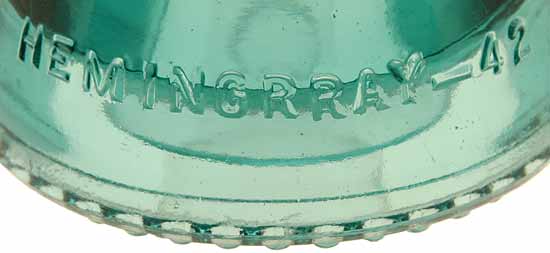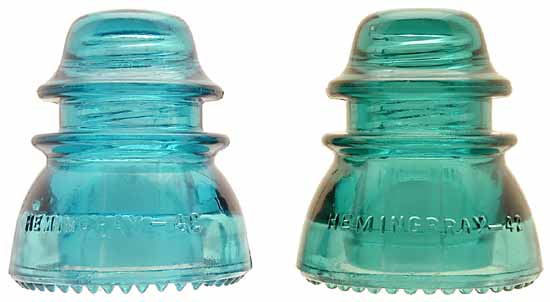Just Another Hemingray-42, or is it?
Several years ago N. R. Woodward and a companion were walking the lines on a section of track in East Texas. Well actually they were walking on the railroad right-of-way where there used to be a line. The line was long gone, but here and there a toppled pole remained. Winter is the perfect time for insulator hunting in Texas. The vegetation is manageable, the temperature is comfortable, the mosquitoes are not plentiful, and all the rattlesnakes are sleeping. It's really the only time that it's possible to examine the ground for insulators. They had not found anything unusual or too exciting, although Woody is always excited when he examines any insulator that he finds or that is presented to him. They had turned up a few Hemingray-42s, Hemingray-45s, and a H.G.CO. CD #145, and were about to call it a day, when Woody's companion, who is not an insulator collector, examined a broken insulator he found at the base of a pole. He called Woody over and asked him: "How many R's in Hemingray?" "One", Woody said. "That's what I thought, but there are two on this one" his friend said. He had found a Hemingray CD #154 with a previously unknown embossing error.
During a subsequent search of the line they discovered five additional insulators with the same embossing error. Beside the badly broken piece, one had considerable damage, one had poor embossing, and three were in NM to VNM condition.
- They are embossed:
- Front Skirt: HEMINGRRAY - 42 {Note spelling}
Rear Skirt: MADE IN U. S. A {Note that there is no period after the A} 
Detail view of the front HEMINGRRAY-42 error
All have 39 round drip points. All are in a Dark Aqua color, which is different from the classic Hemingray Blue, which was more common in the early 1920s.

Contrasting colors: Hemingray Blue (left) with a Dark Aqua (right)
Between August 1981, and August 1982, Mr. Woodward corresponded with John J. Macken, a Hemingray employee, who incidentally claimed the distinction that he was the last person hired by Hemingray before it was acquired by Owens-Illinois in 1933. Mr. Macken told him that the Hemingray blue color came from the high iron content of the sand that was used to produce the glass. The sand was imported from a sandpit in Michigan, the location of which Mr. Woodward is unaware of. In late 1930, or early 1931, at the insistence of Western Electric, their largest customer, Hemingray began production of "clear" glass insulators. Mr. Macken stated that the high iron content of the sand made it very difficult to de-colorize, so Hemingray found other sources for their sand. The glass was not actually crystal clear, but ice blue. In 1936, Hemingray required true clear glass for the production of glass building blocks, and altered their de-colorizing process to produce a crystal clear glass. This same raw glass was used for the production of insulators. Thus ended the era of the Hemingray Blue, and all other aqua colored Hemingray insulators.
Mr. Woodward dates these pieces to 1927. When I asked him how he could do this, he said:
"When you have examined thousands of insulators you just know. I base it on style, color, quality of the workmanship, and slight changes in embossing that occurred over time, either because of changes in the embossings, or degradation in the quality of the embossing on the insulator as the molds wore. To me an insulator is like a face. It's hard to describe the myriad details, but if it's someone you know, every time you see him you immediately recognize him without really knowing how."
So the next time you see a Hemingray - 42, don't just pass it by. Count the R's. Speculation is that these insulators were made for Tony the Tiger. You know what he says about insulators - They're GRREAT!!
![]() Return
to the N. R. Woodward on the Web page
Return
to the N. R. Woodward on the Web page
Thanks are due to
Bill Meier![]() for construction and layout of this
page,
for construction and layout of this
page,
and for his great contribution to the insulator community.
Disclaimer: All information presented here is accurate to the best of my knowledge. It is based on research, personal correspondence, interviews with reliable sources, site visits, etc. When speculation is made, it will be clearly stated as such, and any relevant information used to make statements, whether inductive, deductive, or purely tangential will also be stated. It is not implied that this information is definitive, or total. We are dealing with historical information that was not documented carefully, if at all. I encourage all corrections, comments, criticisms, etc. Please remember that the goal is to increase the knowledge of the insulator community.
COPYRIGHT 2003 by Paul T. Rubin
N.R. Woodward Associates
PO Box 171, Houston, TX 77001-0171
(713) 521-9113
Written Monday, March 3, 2003